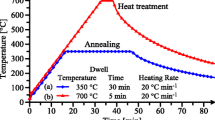Abstract
Numerical modeling was conducted to investigate the deformation behavior of powder mixture during multi-pass drawing processes for multi-filamentary MgB2 wire. A modified Drucker-Prager Cap (DPC) model with an elliptical cap surface using the new material characterization method was developed to capture the anisotropic hardening behavior and hydrostatic effect of the powder mixture. A number of uniaxial die compaction, cold isostatic pressing, diametrical compression, and uniaxial compression tests were conducted using different powder densities to characterize the modified DPC model. A commercial finite element software ABAQUS with a user subroutine was used to simulate the drawing of the MgB2 wire. The density and area fraction of the powder mixture during the wire-drawing process were verified with experimental results. The difference in packing density at the inner and outer filaments of the MgB2 wire was successfully captured by simulation. In addition, the effect of the initial packing density on the superconducting properties of MgB2 wire was numerically studied. It is shown that the increase in the superconducting area, which results from a high initial packing density, should be more effective compared to the increase in the grain connectivity in enhancing the critical current properties for the MgB2 wire when the final packing density is saturated after a number of drawing processes.
Graphic abstract















Similar content being viewed by others
References
X.X. Xi, Rep. Prog. Phys. 71, 116501 (2008)
E.W. Collings, M.D. Sumption, M. Bhatia, M.A. Susner, S.D. Bohnenstiehl, Supercond. Sci. Technol. 21, 103001 (2008)
C. Buzea, T. Yamashita, Supercond. Sci. Technol. 14, 1 (2001)
W.K. Yeoh, S.X. Dou, Physica C 456, 170 (2007)
R.M. Scanlan, A.P. Malozemoff, D.C. Larbalestier, P. IEEE 92, 1639 (2004)
R. Penco, G. Grasso, IEEE T. Appl. Supercon. 17, 2291 (2007)
T. Yagai, S. Mizuno, T. Okubo, S. Mizuochi, M. Kamibayashi, M. Jimbo, T. Takao, N. Hirano, Y. Makida, T. Shintomi, T. Komagome, K. Tsukada, T. Onji, Y. Arai, A. Ishihara, M. Tomita, D. Miyagi, M. Tsuda, T. Hamajima, Cryogenics 96, 75 (2018)
M.A. Susner, T.J. Haugan, A review of the state-of-the-art superconductor technology for high power applications. Paper presented at the 2018 AIAA/IEEE Electric Aircraft Technologies Symposium (EATS), Cincinnati, 12-14 July 2018
D. Zhang, C. Kovacs, J. Rochester, M. Majoros, F. Wan, M.D. Sumption, E.W. Collings, M. Rindfleisch, D. Panik, D. Doll, R. Avonce, M. Tomsic, C. Poole, L. Sabri, T. Baig, M. Martens, Supercond. Sci. Technol. 31, 85013 (2018)
H. Tanaka, T. Suzuki, M. Kodama, T. Koga, H. Watanabe, A. Yamamoto, A.L.M. Wire, IEEE T. Appl. Supercon. 30, 6200105 (2020)
B.A. Glowacki, M. Majoros, Physica C 372–376, 1235 (2002)
R. Flükiger, H.L. Suo, N. Musolino, C. Beneduce, P. Toulemonde, P. Lezza, Physica C 385, 286 (2003)
M. Kodama, K. Tanaka, K. Okamoto, A. Yamamoto, J. Shimoyama, Mater. Res. Express 6, 026003 (2019)
L.B.S. Da Silva, R.G. Souza, A.A. Vianna, E.J. Ribeiro, P.M. Pinto, H. Rigamonti, D. Rodrigues, IEEE T. Appl. Supercon. 28, 6200604 (2018)
B. Yoo, Y. Gyun, K. Jiman, S. Jang, D. Young, H. Jung, T. Lee, Y. Suk, C. Seungyong, H. Haigun, Met. Mater. Int. 25, 1467 (2019)
A. Yamamoto, J.I. Shimoyama, K. Kishio, T. Matsushita, Supercond. Sci. Technol. 20, 658 (2007)
M. Kodama, Y. Ichiki, K. Tanaka, K. Okamoto, A. Yamamoto, J.I. Shimoyama, Supercond. Sci. Technol. 27, 055003 (2014)
M. Kodama, T. Suzuki, H. Tanaka, K. Okishiro, K. Okamoto, G. Nishijima, A. Matsumoto, A. Yamamoto, J.I. Shimoyama, K. Kishio, Supercond. Sci. Technol. 30, 044006 (2017)
A. Morawski, T. Cetner, D. Gajda, A.J. Zaleski, W. Haßler, K. Nenkov, M.A. Rindfleisch, M. Tomsic, P. Przysłupski, Supercond. Sci. Technol. 31, 075008 (2018)
S. Shima, M. Oyane, Int. J. Mech. Sci. 18, 285 (1976)
A.L. Gurson, J. Eng. Mater.-T. ASME 99, 2 (1977)
Y.-S. Lee, Met. Mater. Int. 12, 161 (2006)
Y. Seong, D. Yim, M. Ji, J. Jeong, M. Park, S. Jin, P. Hyoung, S. Kim, Met. Mater. Int. 26, 221 (2020)
R. Shah, S. Tangrila, S. Rachakonda, M. Thirukkonda, J. Electron. Mater. 24, 1781 (1995)
M. Eriksen, J.I. Bech, B. Seifi, N. Bay, IEEE T. Appl. Supercon. 11, 3756 (2001)
J.I. Bech, M.S. Nielsen, M. Eriksen, F. Toussaint, P. Doremus, N. Bay, CIRP Ann.-Manuf. Techn. 50, 201 (2001)
N. Bay, M.S. Nielsen, J. Mater. Process. Tech. 151, 18 (2004)
M.H. Hancock, N. Bay, IEEE T. Appl. Supercon. 17, 3054 (2007)
Y. Lu, Adv. Eng. Res. 128, 233 (2017)
M.S. Nielsen, N. Bay, M. Eriksen, J.I. Bech, M.H. Hancock, Powder Technol. 161, 220 (2006)
L.H. Han, J.A. Elliott, A.C. Bentham, A. Mills, G.E. Amidon, B.C. Hancock, Int. J. Solids Struct. 45, 3088 (2008)
H. Shin, J.B. Kim, Powder Technol. 280, 94 (2015)
D. Hibbit, B. Karlsson, P. Sorensen, ABAQUS/Theory User’s Manual, (Hibbitt, Karlsson & Sorensen, Inc., Rhode Island, (2006)
P. Duda, Int. J. Mech. Sci. 107, 201 (2016)
X. Zhang, H. Jiang, T. Luo, L. Hu, G. Li, J. Cui, Int. J. Mech. Sci. 156, 261 (2019)
G. Milton, A. Sawicki, Appl. Mech. Rev. 56, B27 (2003)
S.P. Timoshenko, J. N. Goodier, Theory of Elasticity, 3rd edn. (McGraw-Hill, New York, 1970)
G. Vega, A. Haddi, A. Imad, Mater. Design 30, 3308 (2009)
H. Park, S.-H. Kim, W.-J. Lee, J.-W. Ha, S.-J. Kim, H.-J. Lee, Met. Mater. Int. 27, 2220 (2021)
Z. Han, P. Skov-Hansen, T. Freltoft, Supercond. Sci. Technol. 10, 371 (1997)
A. Matsumoto, H. Kumakura, H. Kitaguchi, H. Fujii, K. Togano, Physica C 382, 207 (2002)
M.H. Apperley, C.C. Sorrell, A. Crosky, J. Mater. Process. Tech. 102, 193 (2000)
Z. Han, T. Freltoft, Appl. Supercond. 2, 201 (1994)
J. Qi, X. Liu, H. Gao, J. Chen, X. Hu, S. Yan, Int. J. Mech. Sci. 165, 105152 (2020)
D.A. Korzekwa, J.F. Bingert, E.J. Podtburg, P. Miles, Appl. Supercond. 2, 261 (1994)
J.M. Rowell, Supercond. Sci. Technol. 16, R17 (2003)
T. Matsushita, J. Tanigawa, M. Kiuchi, A. Yamamoto, J.I. Shimoyama, K. Kishio, Jpn. J. Appl. Phys. 51, 123103 (2012)
M. Kulich, P. Kováč, M. Hain, A. Rosová, E. Dobročka, Supercond. Sci. Technol. 29, 035004 (2016)
M. Akdoʇan, H. Yetiş, D. Gajda, F. Karaboʇa, A.T. Ülgen, E. Demirtürk, I. Belenli, J. Alloy. Compd. 649, 1007 (2015)
J. Avronsart, C. Berriaud, X. Chaud, C. Hilaire, M. Kazazi, D. Nardelli, M. Tropeano, IEEE T. Appl. Supercon. 28, 6200305 (2018)
J.W. Yoon, D.Y. Yang, K. Chung, Comput. Methods Appl. Mech. Eng. 174, 23 (1999)
J. Lee, D. Kim, Y.S. Lee, H.J. Bong, F. Barlat, M.G. Lee, Comput. Methods Appl. Mech. Eng. 286, 63 (2015)
B. Tang, F. Wu, Z. Wang, S. Zhang, Int. J. Mech. Sci. 157–158, 384 (2019)
H. Yang, H. Li, J. Ma, Z. Zhang, J. Chen, Int. J. Mech. Sci. 157–158, 574 (2019)
H. Choi, J.W. Yoon, Comput. Method. Appl. M. 345, 123 (2019)
Acknowledgement
This work was supported by the Industrial Technology Innovation Program (Project number: 10053590 and N0002598) funded by the Ministry of Trade, Industry & Energy of Korea.
Author information
Authors and Affiliations
Corresponding authors
Additional information
Publisher's Note
Springer Nature remains neutral with regard to jurisdictional claims in published maps and institutional affiliations.
Appendix
Appendix
Based on the incremental elastoplasticity theory, the plastic strain increment \(\Delta {\varepsilon }_{ij}^{pl}\) is written as
where \(\Delta \lambda\) is a plastic multiplier indicating the magnitude of plastic deformation and \(Q\) is a plastic potential function that is continuously differentiable. In Chapter 2, the plastic potential functions of the modified DPC model are expressed as a function of the first and second stress invariants. The Eq. (21) can be expressed by the following equation by hydrostatic-deviatoric decomposition.
where \(p\), \(q\), \({\delta }_{ij}\) and \({S}_{ij}\) are the hydrostatic pressure, the von Mises equivalent stress, the Kronecker delta, and the deviatoric stress tensor, respectively.
The plastic multiplier, \(\Delta \lambda\) which is an unknown parameter, can be determined by the following consistency conditions for the return-mapping method.
where \(F\) is the yield function for the modified DPC model, \(\rho\) is the hardening function, \({{\varvec{\sigma}}}_{n+1}^{trial}={{\varvec{\sigma}}}_{n}+{{\varvec{C}}}^{{\varvec{e}}}\Delta{\varvec{\varepsilon}}\) is the trial stress, and \({{\varvec{C}}}^{{\varvec{e}}}\) is the elastic tangent modulus.
In the iterative process, the potential residual \(R\) is checked by following violated consistency conditions at each iteration \((k)\). When the potential residual is smaller than the tolerance, the stress integration procedure ends.
More information about the stress update algorithm can be found in [51,52,53,54,55].
Rights and permissions
About this article
Cite this article
Oh, YS., Lee, H., Chung, KC. et al. Superconducting MgB2 Wire Drawing Considering Anisotropic Hardening Behavior and Hydrostatic Effect. Met. Mater. Int. 28, 1697–1710 (2022). https://doi.org/10.1007/s12540-021-01023-5
Received:
Accepted:
Published:
Issue Date:
DOI: https://doi.org/10.1007/s12540-021-01023-5




